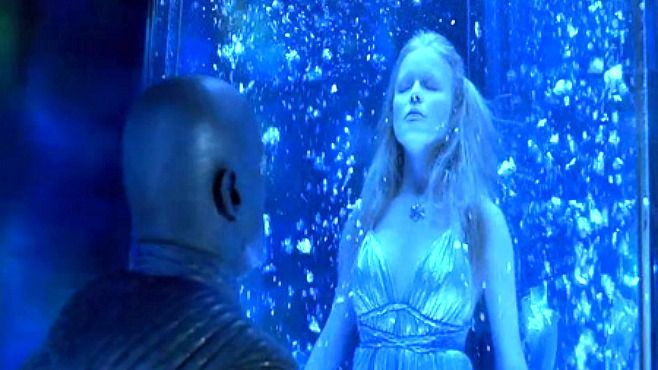Flu Season is coming.
Have you heard? Measles is making a comeback. In celebration of this momentous occasion, we’re here to bring you a list of fictional diseases that you can be confident won’t kill you, even under the encroaching threat of a bunch of real-life diseases that we thought we eliminated.
DISCLAIMER: This column will NOT be listing any diseases where the end result is zombification, because they’re boring and, at the end of the day, the result is the same.
10. Carnosaur Virus (Carnosaur)

This airborne pathogen infects and impregnates women with dinosaur embryos, which Alien their way out of the unwilling mothers’ wombs. Ostensibly the goal of this genetically-engineered virus is to wipe out humans and allow dinosaurs to rule the world once more, but this plan doesn’t seem to have been too well thought through, considering the radically different climate of the modern age.
![]()
9. MacGregor’s Syndrome (Batman & Robin)

Batman & Robin gives the mysterious illness that has plagued Mr. Freeze’s wife since his tragic backstory in Batman the Animated Series a name. While the disease didn’t kill Alfred, thanks to Freeze’s cure, it did kill off this iteration of Batman movies. The Caped Crusader wouldn’t appear on film again until Batman Begins.
8. MM88 (Virus)

Similar to fictional AIDS, MM88 amplifies the negative effects of other viruses and bacterium, making it extremely deadly. The epidemic kills off the entire world population except for 855 people stationed on an Antarctic base. Eventually, everyone dies in a nuclear fire anyway, thanks to a Dr. Strangelove-esque mutually assured destruction system where both American and Soviet nuclear arsenals are all launched.
![]()
7. Red Death (Osmosis Jones)

Uniquely, the disease in this movie is also literally its primary antagonist. Thrax is a walking, talking virus that our protagonists must hunt down, cop movie style. The movie never completely defines exactly what Thrax is, but he affects Frank’s genetics and causes general cold-like symptoms, almost killing his host. Eventually, Thrax meets his end by falling into rubbing alcohol, which is honestly a pretty gruesome death for a cartoon character.
![]()
6. NDS (Absolon)

This film is predicated on a disease version of the premise of Soylent Green. Earth’s population relies on the titular Absolon drug treatment, which staves off the virus. The film’s plot revolves around one police officer’s attempts to unravel the conspiracy behind the drug and the true cure for the virus. It’s basically a whole movie revolving around that tweet that went viral where some Wall Street investor theorized that curing disease is not a sustainable business model.
![]()
5. Greyscale (Game of Thrones)

Yes, yes, Game of Thrones is a TV show, but it’s high enough budget and its method of storytelling leans decisively towards the cinematic. Special shout out to the makeup artists of Game of Thrones for making this disease look truly gross. According to the Game of Thrones wiki, the disease makes flesh harden and split into a fissured pattern, and by the later stages, the necrotic flesh turns dark and resembles scales, hence the name of the disease. The only cured person in recorded Westerosi history is Jorah Mormont, and the treatment is apparently so horrifying that we needed a cutaway to hide it from audience eyes.
![]()
4. Infertility (Children of Men)

Alfonso Cuarón’s 2006 thriller depicts a world where the human population has become infertile and society has collapsed as a result. The film mostly depicts the consequences of the disease, rather than the disease itself. In 2018, I approach this film with a bit of skepticism. First, there’s the implication that millennials wouldn’t be thrilled by this news, since we’re terrified of babies and have low birth rates anyway. Second, the idea that certain demographics of the population wouldn’t riot at the idea that the only fertile woman left on the planet is black is doubtful.
![]()
3. “The Fever” (Cabin Fever)

This bloodborne infection is really gross and based in reality, as necrotizing fasciitis is a real thing that can happen to you (only click the link if you’ve got a strong stomach). Probably bacterial, given its ability to spread between species, the most dangerous thing about this pathogen is that nobody wants to talk about it, allowing it to spread potentially forever, as the endings of the Cabin Fever movies imply.
![]()
2. MEV-1 (Contagion)

I will admit that I’m biased towards this one for two reasons: 1). This is my father’s favorite film for its accurate depiction of outbreak-response procedural, and 2). The CDC is in Atlanta, my home. As CDC scientists work on a cure, the world responds to MEV-1 as best it can, from distrust and paranoia between members of the populace to high stress and intense workplace pressures of the CDC, to even a disaster profiteer played by Jude Law. This pathogen reveals the humanity and desperation of everyone in the world of the film. As the tagline suggests, the real disease that spreads among humanity is fear.
After watching this movie in theaters, my friend faked a violent cough as we walked to the parking lot.
![]()
1. Simian Flu (Planet of the Apes series)

ALZ-113 is interesting because it demonstrates radically different symptoms between apes and humans. While it enhances the intelligence of apes, allowing them to form a human-like civilization in less than a generation, it straight-up kills humans. The mutant strain later “devolves” humans, but the only demonstrable example of this is Nova, the little girl who is still capable of expressing emotion and empathy. Meanwhile, the more humanlike Caesar begins to show a more warlike and vengeful disposition by the end of the series, raising the interesting moral quandary: What really defines intelligence?
The post 10 Fictional Diseases We Hope to Never Encounter appeared first on Film School Rejects.


0 comments:
Post a Comment